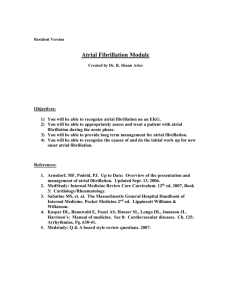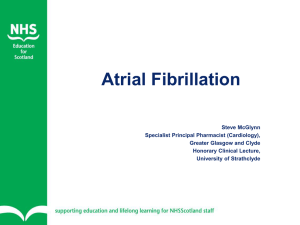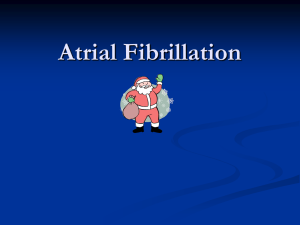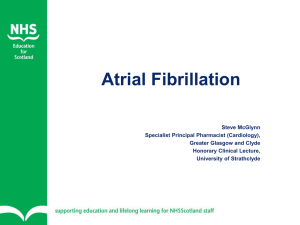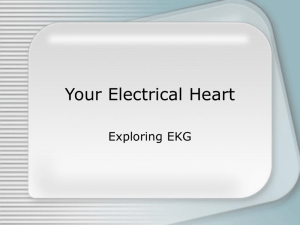Atrial fibrillation - The Heart Foundation
advertisement
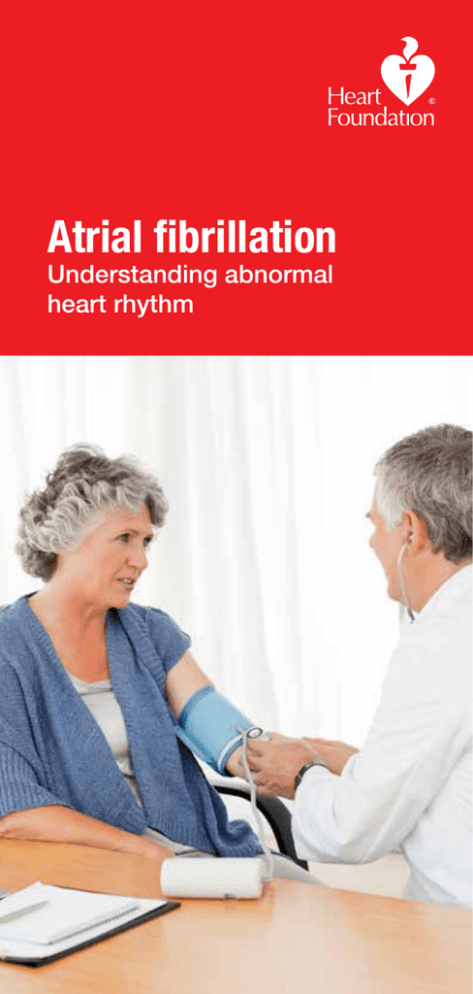
Atrial fibrillation Understanding abnormal heart rhythm What is atrial fibrillation (AF)? AF is a common and important disturbance of the electrical system of the heart. It is one of a number of disorders commonly referred to as ‘arrhythmias’ or ‘dysrhythmias’, in which the heart beats with an abnormal rhythm. If not recognised and correctly treated, AF can result in significant problems, including stroke and heart failure. The normal heart rhythm The heart is a highly efficient pump with four chambers (refer to Figure 1). The two chambers on the right side of the heart receive oxygen-poor (blue) blood from the body and pump this blood to the lungs, where it receives oxygen. The oxygen-rich (red) blood returns to the left side of the heart, and the two left chambers pump this oxygenated blood to the rest of the body. The lower (major) pumping chambers, the ‘ventricles’, receive blood from the top chambers, the ‘atria’, and do the hard work of pumping the blood to the other parts of the body. In a normal heart, the atria contract (squeeze) first, pushing blood into the ventricles. The ventricles then contract; the right ventricle pumping the blood out to the lungs and the left ventricle pumping blood to the rest of the body. This process repeats at a regular rate, usually around 60 to 100 times every minute. Normally, the contraction of the atria is set off by tiny electrical signals that come from the heart’s natural ‘pacemaker’ – a small area of the heart called the sinus node that is located in the top of the right atrium. These signals travel rapidly throughout the atria to ensure that all the muscle fibres contract at the same time, pushing blood into the ventricles. 2 National Heart Foundation of Australia These same electrical signals are passed on to the ventricles via the atrioventricular (AV) node and cause the ventricles to contract a short time later, after they have been filled with blood from the atria. This normal heart rhythm is known as ‘sinus rhythm’, because it is controlled by the sinus node. Aorta Sinus node Pulmonary artery Left atrium, collecting chamber Pulmonary veins Pulmonary veins Atrioventricular node Left ventricle, pumping chamber Right atrium, collecting chamber Right ventricle, pumping chamber Figure 1. Normal electrical control of the heart beat What happens in AF? AF occurs when there are abnormal electrical impulses in the atria. In AF, ‘waves’ of uncontrolled electrical signals travel through the atria, rather than the normal, highly regulated signals from the sinus node. These waves often start in one or more of the four veins that bring blood from the lungs into the heart (the pulmonary veins). These signals cause the muscle fibres in the atria to contract out of time with each other, and the atria ‘quiver’ (or, in medical terms, ‘fibrillate’). Some of this abnormal electrical activity is passed on to the ventricles, causing a rapid and irregular heartbeat. When the heart is in AF, it is not pumping regularly and, therefore, not working as efficiently as it should be. Atrial fibrillation 3 What are the symptoms of AF? What causes AF? If you have AF, you may experience palpitations – that is, you become aware of your heartbeat and you may actually feel irregular ‘fluttering’ of the heart. This fluttering is caused by the abnormal electrical signals in the atria reaching the ventricles and causing them to beat too rapidly and in an irregular pattern. Some people may notice that they have an irregular pulse. AF may also cause general feelings of fatigue, weakness, exercise intolerance, discomfort or dizziness, because the heart is not pumping efficiently. Occasionally this may result in fainting or collapse. The most common causes of AF are long-term high blood pressure, coronary heart disease (reduced blood flow to the heart caused by clogging of the arteries) or valvular heart disease (problems with the valves of the heart that normally keep blood flowing in the right direction). Another less common, but treatable, cause is hyperthyroidism (an overactive thyroid gland). Some people with AF may not notice any symptoms, however, it is still important to treat the condition, because it can lead to other problems. Who does AF affect? AF is one of the most common types of arrhythmia, occurring in about 2% of the general population. It is particularly common in older people, affecting 5% of people over the age of 65 years. The number of people affected by AF rises with age. Atrial fibrillation (AF) is a type of arrhythmia, a condition in which the heart beats with an abnormal rhythm. If not recognised and correctly treated, AF can result in significant problems, including stroke and heart failure. 4 National Heart Foundation of Australia AF can also be associated with chest trauma and/ or surgery, caffeine intake and excessive alcohol consumption. Certain types of medicine, as well as some diseases such as pneumonia, can ‘trigger’ AF, but sometimes there is no apparent cause – it just happens. Some people experience AF as a one-off episode; in others, it may come and go (‘paroxysmal’ AF) or persist (‘permanent’ or ‘chronic’ AF). Why is it important to recognise and treat AF? AF can cause a number of symptoms, as described above, and may indicate an underlying heart or blood vessel disease. One of the most important problems associated with AF is that it may to lead to the development of a blood clot inside the atria. This can occur when the atria are not beating properly. In this situation, the blood does not flow normally through the heart, allowing blood to collect or ‘pool’ and leading to an increased risk of a clot forming. A portion or portions of this clot (‘embolus’ or ‘emboli’) can then break off and be carried from the heart through the bloodstream into smaller and smaller blood vessels until they get stuck, potentially blocking the blood supply to important organs. If the blockage occurs in a blood vessel supplying the brain, it can cause a stroke. Without treatment, the risk of stroke among people aged over 65 years with AF is about one in 20 per year, which is five Atrial fibrillation 5 to six times higher than those of similar age. The risk may be even higher if the AF is associated with damaged or diseased heart valves, or if the person has a history of high blood pressure, diabetes, heart failure or stroke. What treatments are available? If AF is suspected, a number of tests, including an electrocardiogram (ECG) and echocardiography (ultrasound of the heart) are usually done to confirm the diagnosis and look for any underlying cause (e.g. diseased heart valves) before treatment options are considered. • the severity of symptoms The best treatment for AF depends on a number of factors, including: • the cause (if known) and duration of AF • the person’s overall risk of stroke and other problems caused by emboli • the risks of a particular therapy for that person. Is AF ‘curable’? Often, the heart will return to a normal rhythm without treatment. In other cases, a normal heart rhythm may be restored through cardioversion procedures (refer to ‘Cardioversion – restoring normal rhythm’ below). However, in either case, AF may recur, despite the use of medicines to maintain sinus rhythm. If this happens often, or for prolonged periods, patients are at increased risk of blood clots forming in the atria and causing problems. For this reason, when frequent episodes of AF persist, ongoing blood thinning (anticoagulant) medicine is generally prescribed to reduce the chance of blood clotting in the heart and the risk of emboli developing. In addition, medicine is typically used to slow the heart rate in people whose hearts are beating too fast (and causing unpleasant symptoms of irregular rapid palpitations or weakness). Most people with AF will need to take medicine to prevent blood clots from forming. In addition, treatments may be needed to prevent the heart from beating too fast or to restore and maintain a normal heart rhythm. In some people, such as those with infrequent AF, long-term medicine may be all that is required to treat AF. In people with chronic AF, cardioversion techniques may be used to restore a normal heart rhythm. If these approaches can’t be used or are unsuccessful, ablation procedures may be considered. These methods are described below. Cardioversion – restoring normal rhythm For people with a prolonged or particularly serious episode of AF, ‘cardioversion’ may be used to return the heart to a normal rhythm. After cardioversion, long-term medicines are often prescribed to prevent AF recurring (refer to ’Long-term medicines’ below). Electrical cardioversion In this procedure, the heart is given an electrical ‘shock’ (while under an anaesthetic) to help restore a normal rhythm and reduce long-term risks associated with AF. Electrical cardioversion is very safe; the only risk is the procedure could dislodge a blood clot that may have already formed in an atria. This risk is small and reduced further by checking for existing blood clots with a test called a ‘trans-oesophageal’ echocardiogram (which 6 National Heart Foundation of Australia Atrial fibrillation 7 takes ultrasound images of the heart from inside the oesophagus) and by giving the person blood-thinning medicines before and after the procedure. Electrical cardioversion only takes a few minutes. Pharmacological cardioversion Some medicines (such as flecainide, sotalol and amiodarone) can be used to revert the abnormal electrical rhythm of the heart to normal. This is known as ‘pharmacological cardioversion’. These medicines may be given as tablets or as an injection, and may also need to be taken regularly in the longer term to maintain sinus rhythm. Long-term medicines For most people with AF, a combination of ongoing medicines will be recommended to help to maintain a normal heart rhythm, slow the rate at which the heart beats and/or reduce the risk of stroke and other problems caused by emboli. This is true even for many people who undergo cardioversion or ablation procedures. Some of the most common medicines used for these purposes are explained below. Slowing the heart rate and maintaining normal rhythm Some medicines, such as digoxin, beta-blockers and some (but not all) calcium channel blockers, help to slow the heart rate by increasing the time taken for the ventricles to fill with blood before they contract and pump the blood to other parts of the body. Others (including sotalol, flecainide and amiodarone) are known as ‘antiarrhythmic agents’, and work by normalising and maintaining the electrical rhythm of the heart. 8 National Heart Foundation of Australia Thinning the blood Most people with AF will be prescribed medicine to thin the blood to prevent clotting. This will decrease the risk of stroke or other problems caused by emboli. The most common medicine used for this purpose in the past has been warfarin. Alternative anticoagulant medications to warfarin have been developed and are now approved for use in Australia. These newer medications include apixaban, dabigatran and rivaroxaban, and have been shown to be of similar efficacy to warfarin but do not require blood tests (International Normalised Ratio or INR monitoring) to assess blood thinning. Like warfarin, they carry an extra risk of bleeding. The decision to prescribe one of these medicines will be based on a balance between reducing the risk of blood clots and emboli forming and the likelihood of excessive bleeding in an individual patient, which can be assessed by the person’s doctor. People taking warfarin need to be careful that they take the dose they are prescribed at the same time each day, and regular INR monitoring is done to make sure the dose is correct. This means that the recommended dose may change. The frequency of INR monitoring will be high initially until the dose is stabilised; but even after this, will need to continue at regular intervals (usually monthly) indefinitely to ensure that the dosage is effective without unduly increasing the risk of side effects. There are several things, such as eating patterns and use of other medicines, that can affect the way warfarin works, and these need to be considered and controlled (refer to ‘Lifestyle management’ and ‘Warfarin’ below). In addition, the newer anticoagulant medications are less affected by diet and other medications compared with warfarin, and are given as a standard dose which may be reduced in some patients (e.g. those with reduced kidney function, older patients or those with low body weight). These newer agents may not be as easily reversed as warfarin in emergency situations. Atrial fibrillation 9 People taking warfarin or any of the alternative anticoagulant medications should report any unusual bleeding or bruising to their doctor. Warfarin People taking warfarin need to be aware that certain types of foods can either enhance or inhibit the effects of the drug. Foods high in vitamin K, such as leafy green vegetables, can reduce the effect of warfarin; some dietary supplements may increase the effects of warfarin. It is important to remember that these foods should not be avoided altogether, but people taking warfarin should try to keep their intake of these foods fairly consistent. Foods to be aware of include: • leafy green vegetables (such as spinach, broccoli, lettuce, cabbage, asparagus, parsley, watercress, brussels sprouts) • canola, olive and soybean oils • seaweed (such as in sushi) • green and herbal teas • liver • spring onions. People taking warfarin should talk to a doctor first if they are considering changes to their eating habits (for example, switching to a vegetarian diet, following a special meal plan to lose or gain weight, or starting or discontinuing any dietary supplements, such as fish oil supplements). Ablation procedures ‘Ablation’ refers to removing or ‘inactivating’ small areas of tissue in the body – in the case of AF, the area(s) of the heart responsible for creating or passing on the abnormal electrical signals in the atria. These procedures are not done often and generally only in people whose AF recurs despite cardioversion and ongoing medicine, or in those for whom medicine options are unsuitable. Catheter ablation In catheter ablation, a long, thin tube (or ‘catheter’) is inserted into a blood vessel in the leg and threaded through the vessel until the tip reaches the heart. The catheter’s tip has an electrode that can emit radiofrequency waves to ‘burn’ and inactivate the target area(s). Catheter ablation may take 1–2 hours. It is performed under a light general anaesthetic. Surgical ablation Surgical treatment of AF is very rarely necessary, and usually only done when other heart surgery is also needed. One technique occasionally used to treat AF is known as the ‘maze operation’. In this procedure, a number of lesions are created in the atria of the heart, often around the pulmonary vein, to isolate abnormal electrical currents, stopping them from travelling throughout the atria and causing abnormal beating patterns. An artificial pacemaker will sometimes be implanted at the same time to take over the electrical control of the heart. Alcohol consumption should be limited, as it also can alter the effectiveness of warfarin. For more information, contact the NPS MedicineWise Medicines Line on 1300 633 424. 10 National Heart Foundation of Australia Atrial fibrillation 11 Lifestyle management In most people, AF can be well controlled, and they continue to lead a relatively normal and healthy lifestyle. However, as AF is often associated with other forms of cardiovascular disease, consideration should be given to common risk factors for cardiovascular disease. Avoiding smoking, enjoying healthy eating, being physically active, controlling blood pressure and achieving and maintaining a healthy body weight are important ways to minimise the risk of cardiovascular disease. People with diabetes should make sure that their diabetes is well controlled. Healthy eating Enjoying healthy eating is important for everybody’s heart health. However, people with AF, especially those taking warfarin, may need to pay particular attention to their eating patterns (refer to ‘Warfarin’ box above). Physical activity People with heart disease get the same benefits from regular moderate physical activity as other people. However, it is recommended that people with AF talk to their doctor or other health professional about the level of activity that is right for them. People taking warfarin may be advised to avoid particularly physical or competitive sports where there is a significant chance of injury, due to the risk of excessive bleeding. 12 National Heart Foundation of Australia Atrial fibrillation 13 When should I seek medical attention? If you have AF, you should see a doctor if palpitations, dizziness or other symptoms persist. Symptoms of heart attack* or stroke† should be treated as an emergency. You should call an ambulance by dialling Triple Zero (000). If you are taking warfarin, or other anticoagulant medication, you should also look out for any signs of abnormal bleeding. *Symptoms include tightness, pressure, heaviness or pain in one or more of your chest, neck, jaw, shoulder/s, back or arm/s. This pain or discomfort may start in your chest and spread to these other areas of your upper body. You may not get chest pain at all but just feel pain or discomfort in one or more of these other areas. You may have a choking feeling in your throat. Your arms may feel heavy or useless. You may also feel short of breath, break out in a cold sweat, experience nausea, and/ or feel dizzy or light-headed. † Symptoms of stroke may include one or a combination of weakness, numbness or paralysis of the face, arm or leg on either or both sides of the body; difficulty speaking or understanding; dizziness, loss of balance or an unexplained fall; loss of vision, sudden blurred or decreased vision in one or both eyes; headache, usually severe and of abrupt onset, or unexplained change in the pattern of headaches; and/or difficulty swallowing. Want to know more? For more information, call our Health Information Service on 1300 36 27 87 (local call cost) and talk to one of our trained health professionals. You can also visit www.heartfoundation.org.au A note about cardiac rehabilitation The Heart Foundation and the World Health Organization recommend that all patients with heart disease attend an appropriate cardiac rehabilitation and prevention program. Some hospitals and community health centres run outpatient cardiac rehabilitation programs. These programs continue the gradual increase in physical activity started in hospital and provide you and your family with education, information and support. You should attend a cardiac rehabilitation program as soon as possible after hospital discharge. The right rehabilitation program will help most people to reduce their risk of further heart problems. 14 National Heart Foundation of Australia Atrial fibrillation 15 For heart health information, please contact us 1300 36 27 87 heartfoundation.org.au Acknowledgements We would like to thank Clinical Professor Graeme Hankey of the Stroke Unit at Royal Perth Hospital and the School of Medicine and Pharmacology at the University of Western Australia for his assistance in preparing this information. This publication is based on INF-004-C.v3, which was first published 2004 and reprinted with corrections 2008, 2010, 2015. © 2016 National Heart Foundation of Australia, ABN 98 008 419 761 Cover image: wavebreakmedia, Shutterstock.com Terms of use: This material has been developed for general information and educational purposes only. It does not constitute medical advice. Please consult your healthcare provider if you have, or suspect you have, a health problem. The health information provided has been developed by the Heart Foundation and is based on independent research and the available scientific evidence at the time of writing. The information is obtained and developed from a variety of sources including, but not limited to, collaborations with third parties and information provided by third parties under licence. It is not an endorsement of any organisation, product or service. While care has been taken in preparing the content of this material, the National Heart Foundation of Australia, its employees and related parties cannot accept any liability, including for any loss or damage, resulting from the reliance on the content, or for its accuracy, currency and completeness. This material may be found in third parties’ programs or materials (including, but not limited to, show bags or advertising kits). This does not imply an endorsement or recommendation by the National Heart Foundation of Australia for such third parties’ organisations, products or services, including their materials or information. Any use of National Heart Foundation of Australia materials or information by another person or organisation is at the user’s own risk. The entire contents of this material are subject to copyright protection. Enquiries concerning permissions should be directed to copyright@heartfoundation.org.au CON-175
